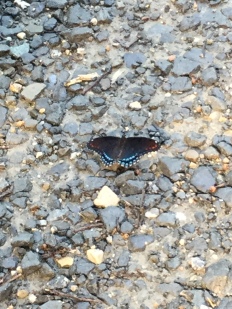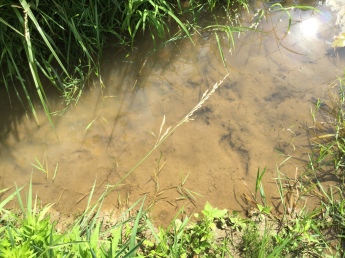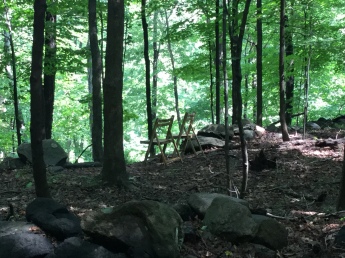I arrived at 8:40AM. The air was humid yet again, although the temperature was relatively cool (mid-70s). Rain had fallen the night before. Steam was rising from the driveway. The earth was damp. A breeze shook water off the trees. I listened to the robins scold, a wood thrush sing, a flicker and a pewee called, and a small group of young titmice buzz.
A Red-spotted Purple butterfly landed on the gravel behind my car. Although I’m less knowledgeable about insects, I’ve learned a few names from Mike over the past couple years. I would keep my eyes on the butterflies, moths, and dragonflies as well as the birds during this hike. As if they knew July 1 had passed, the insects climbed so high in numbers it’s become impossible to turn every angle and not see delicate wings flutter.

Red-spotted Purple butterfly. © S.G. Hansen
I heard a male Indigo Bunting sing at the kiosk intersection. I tried finding him, but his song bounced around the trees so well that he remained hidden. I pressed along to the field, where another bunting was singing at the top of a tree behind the grasses. I couldn’t figure out which was the parent of the immature bunting I saw last month. I don’t think immatures grow up so fast, although Indigo Buntings can have up to two broods per year, and it maybe that another male found good territory adjacent to the first.
I lingered for a few minutes. A couple of Great Spangled Fritillary butterflies fed on the two flowering milkweed bushes. A few cabbage whites and gypsy moths flickered around aimlessly. While trying to get more looks at this second male bunting, I noticed movement in a nearby, shorter tree. A female Scarlet Tanager (colored dull yellow) and a young Blue-gray Gnatcatcher forage so swiftly that they disappeared further into the trees after only ten seconds.
At the pond, I immediately spotted the Great Blue Heron that my friend Christine (also a Saw Mill River Audubon board of director) saw during the Second Saturday hike a couple days ago. It stood very still at the southwestern corner. Its chest was stripey, indicating it was an immature.
Lily pads almost completely covered the water. Numerous dragonflies whizzed above the water (nameless, as they were too far away and too small for me to see clearly). Red-winged Blackbirds and Common Grackles called from all around. A young Downy Woodpecker – plumage ruffled and imperfect – loudly cried. A pair of Carolina Wrens engaged in spat: one trilled and the other chattered. I flushed a dozen robins as I further ambled along the pond.
As I started hiking up the blue trail to the powerlines, I encountered two different groups of young titmice. A Scarlet Tanager call repeatedly: Chik-burr. A Blue-headed Vireo languidly sang.
A Blue Jay landed on a sapling next to the trail, and then it flew out of sight shortly after. I thought I heard it poorly imitating a Red-tailed Hawk. But when the calling continued and a grey squirrel started scolding, I knew to look for the Real McCoy. (I hear jays imitating Red-tails more often that I hear the Red-tails themselves. Sometimes the jays sound impeccable, but most of the time they sound like Blue Jays imitating Red-tailed Hawks). It was somewhere along the edge of the forest. When I moved a bit off the trail to get a sight of it, the hawk flew away.
At the top of hill, I flushed even more robins. A Field Sparrow and a House Wren sang. I heard a towhee utter Drink your tea repeatedly from the powerlines. The rhythm if this call was different from last month’s towhee. The “Drink your” sounded like eighth notes rather than sixteenth notes.
Just after I ventured out to the powerlines, four immature Red-winged Blackbirds flocked to a bush and called and called, either curious or furious about my presence. Either way, they took off when I continued walking.
I felt slightly hotter now that I was under the sun. Not as bad as last month, but still quite bright. I heard a third Indigo Bunting, two more towhees, a second House Wren, and a mockingbird sing up ahead. Many nameless small butterflies or moths fluttered or zipped around. Bumblees, honeybees, another fritillary, and one Eastern Tiger Swallowtail drank nectar from the milkweed, more widespread here, pictured below.

Milkweed flowers are one of the more cheery sights of summer. © S.G. Hansen
I unintentionally flushed a female Baltimore Oriole, who was presumably feeding on berries, still sticking out like a sore thumb despite her muted yellow plumage. Shortly after, four immature orioles gathered on single bush. They called sporadically as they were perched. They didn’t seem to understand what to do, as if unsure what to make of me. Like the blackbirds, they, too, stared at me. I had my best look at young Baltimore Orioles yet – a excellent opportunity to unhurriedly note their washed-out orange plumage and their gray and white wings. As soon as I pressed forward, they flew to the trees, where they flitted around in search of food. Two young catbirds took over the bush.

An osprey flying over may have dropped this partial fish skeleton. © S.G. Hansen
A miniature pond had formed on small section the path from a stream of water trickling down. I had to jump my way across. I gingerly took a step, and then another step. Five young turtles suddenly darted from the grass I nearly stepped on, dived into the water, and buried themselves under the mud. During that split second they jumped, I could see that their shells were dark with orange lines.

They’re under there somewhere… © S.G. Hansen
I spooked so many robins every few yards the entire length I walked. They tore from out inside the berry-laden vegetation, crying Yeep! or Cuck cuck cuck! I lost count of the gray blurs and started rolling an estimated number, around three dozen. Many were adult age, though a few were speckle-breasted young. I didn’t expect so many robins here. Christine didn’t see so many on Saturday. This is the kind of number I would observe in the winter, the time when robins generally flock in larger numbers. Perhaps the individuals that are already done with breeding are now on the nomadic move.
Now back in the sanctuary, underneath the cool canopy shade, I heard the same Hairy Woodpecker family I saw last month. But after that, my descent on the white and red trails were quiet, with the exception of another young titmouse group. The number of robins sighted dropped drastically, although I did see a few more.

Have a seat, I guess. Do a big sit. © S.G. Hansen
On the yellow trail once again – the other half of the pond loop – I began hearing the wood thrushes and pewees again. The Scarlet Tanager I heard calling from before was now singing. A group of a half-dozen or so Blue Jays jay-ed boisterously. I thought they were mobbing a raptor, but when I got close, they shut up. They were only talking to one another, apparently. I find it difficult to discern whether jays are talking or mobbing. (Personally, crows are easier.)
Towards trail’s end, I heard a pair Wood Thrushes duel. Down the trail, I saw a Red-trailed Hawk land high in a tree. A grackle and a blackbird moved in to protest its presence. It flew away promptly. I couldn’t tell if this was the same hawk from before, or a different one. I played in safe; I kept my Red-tail count at 1.
I observed 32 species on this hike. I was happy to exceed my goal of 25 and to hear a lot more singing from the migrants than I expected. Wood Thrushes and pewees, yes, but not Indigo Buntings and Scarlet Tanagers. Funny enough, no Red-eyed Vireos!
You can view the eBird list here.